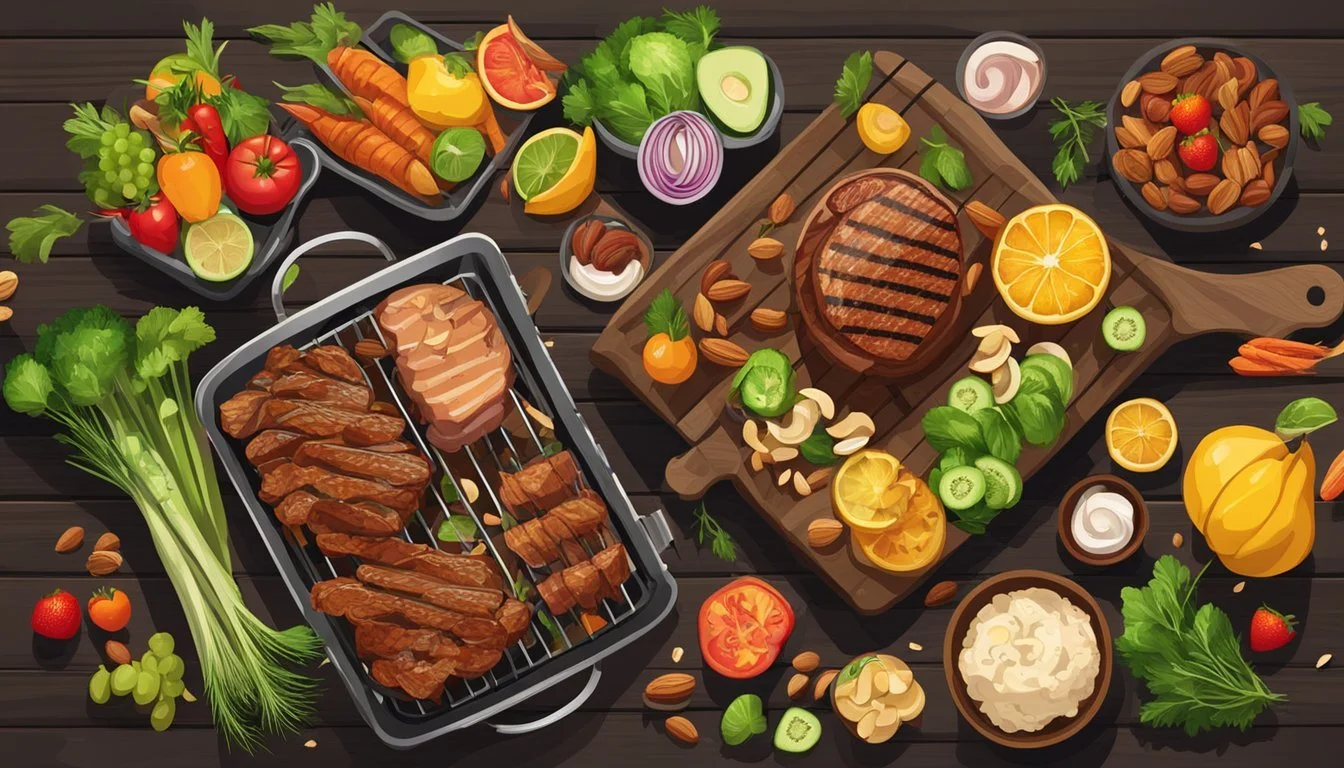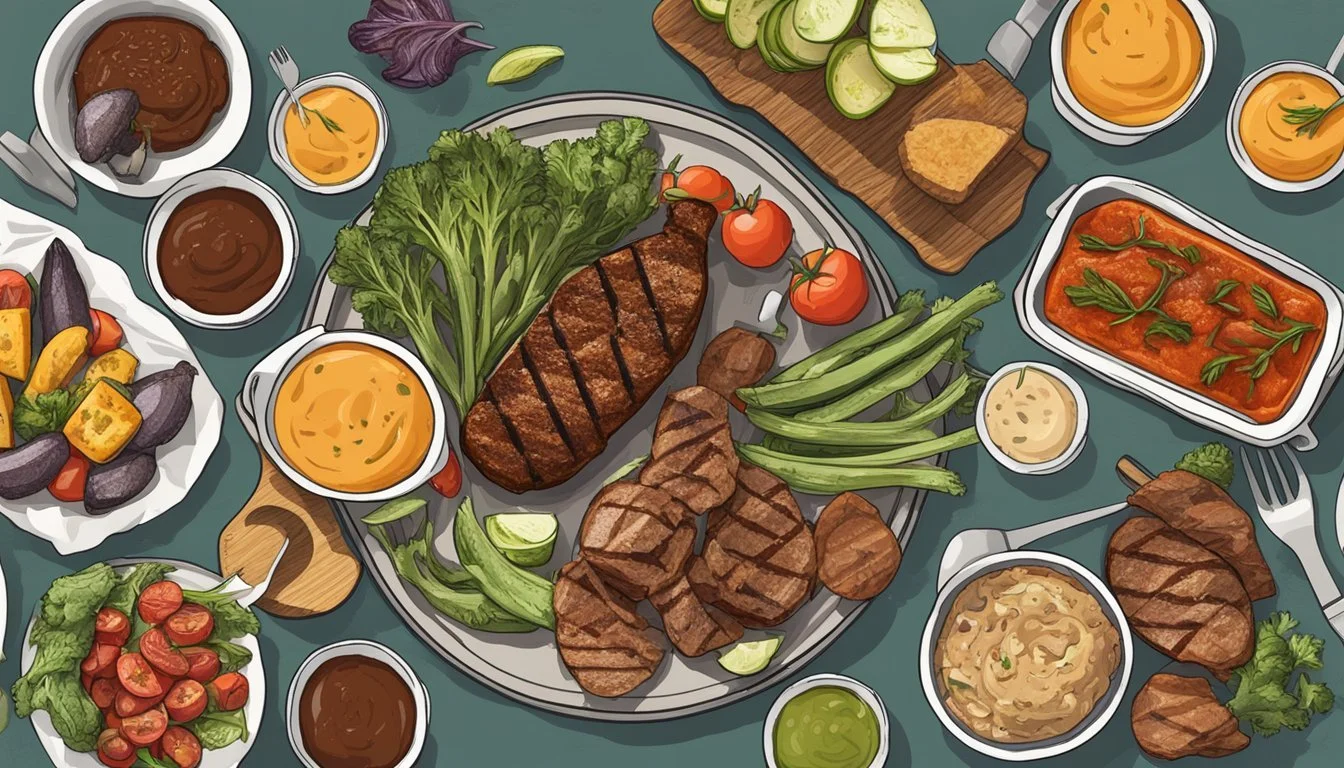How to Host a Paleo-Friendly Barbecue
Tips for a Healthy Grill-out
Hosting a barbecue (What wine goes well with barbecue?) can be a delightful experience that brings friends and family together over a love of good food and sunshine. However, for those following a paleo diet, traditional barbecue fare can present a minefield of grains, legumes, and processed foods that are off-limits. A paleo-friendly barbecue focuses on whole foods, with an emphasis on quality meats, fresh vegetables, and natural fats, all of which align with the principles of a pre-agricultural diet.
To create a satisfying paleo barbecue, hosts should plan their menu with care, ensuring that it caters to the dietary restrictions without compromising on flavor or variety. Options like grass-fed beef, free-range chicken, and wild-caught fish serve as excellent protein sources, and they can be grilled to perfection alongside a selection of vegetables like bell peppers (What wine goes well with bell peppers?), asparagus (how long does asparagus last?), and sweet potatoes. Fresh salads with an assortment of greens, nuts, and fruits can complement the proteins, creating a well-rounded meal that will cater to paleo and non-paleo guests alike.
Selecting the right recipes and preparing in advance transforms a simple backyard gathering into a stress-free event that accommodates all dietary needs. By considering the paleo guidelines and choosing ingredients that are both nutritious and delicious, hosts can ensure every guest enjoys the barbecue while sticking to their healthy lifestyle. With thoughtful preparation and an array of suitable dishes, anyone can host a paleo-friendly barbecue that is both enjoyable and aligned with the principles of the diet.
Understanding the Paleo Diet
The Paleo Diet focuses on consuming whole foods that our hunter-gatherer ancestors might have eaten, emphasizing nutritional quality and natural sourcing.
Key Principles and Foods
The Paleo Diet revolves around a return to the dietary habits of Paleolithic humans. One consumes foods presumed to have been available before the advent of agriculture and processed foods. It is built upon certain key principles:
High consumption of vegetables and fruits, which are rich sources of vitamins, minerals, and fiber.
Inclusion of ample lean meats and seafood to provide essential protein and omega-3 fatty acids.
Avoidance of grains, legumes, and refined sugars, as these are considered products of modern agriculture and industrialization.
Foods to Emphasize:
Vegetables: Leafy greens, root vegetables, and others
Fruits: Berries, apples, oranges, and any other non-processed variety
Meats: Grass-fed beef, free-range poultry
Seafood: Wild-caught fish like salmon and mackerel
Nuts and seeds
Foods to Avoid:
Grains: Wheat, rice, oats, etc.
Refined sugars and sweeteners
Processed foods and snacks
Health Benefits
Proponents of the Paleo Diet suggest that it can lead to several health benefits, stemming from the high nutritional value of unprocessed foods and balanced macronutrient distribution. Some potential benefits include:
Weight Loss: The diet's emphasis on lean proteins and vegetables can lead to a reduction in calorie intake and subsequent weight loss.
Improved Metabolism: The removal of refined sugars and grains may help stabilize blood sugar and improve insulin sensitivity.
Nutrient-Rich: A diverse intake of fruits, vegetables, and lean meats provides a wide spectrum of vitamins, minerals, and antioxidants.
Despite positive anecdotal reports, it's important to note that individual experiences with the Paleo Diet may vary, and consultation with a healthcare provider is advised before making significant dietary changes.
Planning Your Barbecue
When hosting a Paleo-friendly barbecue, it is crucial to consider the guests' food preferences, choose the right date accounting for weather, and select suitable grilling equipment to ensure a successful event.
Guest List and Dietary Preferences
One should meticulously compile the guest list, ensuring awareness of any dietary restrictions, with a particular focus on Paleo preferences. They must communicate clearly with the attendees ahead of time to ascertain that everyone's dietary needs are met, thus avoiding any grains, legumes, or dairy products, which are not Paleo-compliant.
Confirm Dietary Preferences: Reach out to guests for any specific requirements.
Paleo-friendly Options: Plan a menu that consists predominantly of meats, vegetables, and fruits.
Picking the Right Date and Weather
The host must check the local weather forecast before selecting a date for the barbecue. One should aim for a day with minimal chance of rain and a comfortable temperature that will encourage guests to enjoy the outdoor atmosphere.
Check Weather Forecasts: Opt for a day with clear skies and moderate temperatures.
Plan for Contingencies: Have a backup plan, such as tents or an indoor space, in case of unpredicted weather changes.
Selection of Grilling Equipment
Selecting the proper grilling equipment is vital to preparing Paleo-friendly dishes. Grills that provide consistent heat and can accommodate the size of the gathering are preferred. The host should ensure the grill is clean and in good working order well before the barbecue day.
Grill Types: Gas, charcoal, or electric grills, each offering distinct flavors and conveniences.
Maintenance and Cleaning: Thoroughly clean grates and check fuel supplies or electrical connections.
Choosing Paleo-Friendly Ingredients
When hosting a paleo-friendly barbecue, the priority lies in sourcing main ingredients that adhere to paleo principles, focusing on quality meats, fresh produce, and avoiding grains and refined sugars.
Selecting Quality Meats and Seafood
One should opt for grass-fed meats and organic chicken, as they are staples of the paleo diet, ensuring that the animals were raised and processed following natural practices. Seafood should be wild-caught, rich in omega-3 fatty acids and free from contaminants. At the barbecue, the main attractions could include:
Beef: Ribeye, sirloin, or T-bone steaks
Poultry: Chicken thighs (What wine goes well with chicken thighs?) or drumsticks
Pork: Chops or tenderloin
Seafood: Shrimp skewers, salmon fillets, or fresh tuna
Finding Fresh Produce
Vegetables and fruits are integral to a paleo barbecue, offering vitamins, minerals, and fiber. One should source:
Vegetables: Zucchini, bell peppers (What wine goes well with bell peppers?), asparagus, and onions for grilling
Leafy Greens: To create salads or wraps
Fruits: Such as pineapple or mango, which can be grilled for a sweet contrast to savory dishes.
Avocados can be a versatile addition, ideal for guacamoles or simply sliced as a side.
Avoiding Refined Sugars and Grains
In preparing sauces and marinades, it's essential to avoid ingredients that fall outside of paleo recommendations. This includes refined sugars and grains. Sweeteners like honey can be used as a natural alternative. Here are some suggestions for paleo-friendly condiment bases:
Sauces: Use tomato paste, apple cider vinegar, and spices.
Dressings: Olive oil and lemon juice mixed with herbs for salads.
Marinades: Combine citrus juice, olive oil, and garlic for marinating meats.
To adhere to the paleo diet, one must exclude grains such as wheat, rice, and corn, as well as foods containing refined sugars from the barbecue menu.
Crafting the Perfect Marinades and Rubs
Creating marinades and rubs with a paleo-friendly twist is essential for a barbecue that caters to this dietary choice. Utilizing natural ingredients and avoiding processed sugars, grains, and additives, ensures the barbecue offerings are both delicious and aligned with paleo principles.
Homemade Spice Blends
One can craft their own spice blends using ingredients like sea salt, black pepper, garlic powder, onion powder, chili powder, and cumin to ensure all marinades and rubs are paleo-approved. Here's a simple homemade spice blend to get you started:
2 teaspoons sea salt
2 teaspoons black pepper
1 teaspoon garlic powder
1 teaspoon onion powder
1 teaspoon chili powder
1/2 teaspoon cumin
Mix the spices well and store them in an airtight container. This blend works perfectly as a base for dry rubs or as a flavor enhancer for marinades.
Utilizing Natural Sweeteners
When one needs to add a touch of sweetness to their marinades or sauces, natural sweeteners like coconut sugar or honey can be an excellent paleo substitute for processed sugars. For instance, combining coconut sugar with apple cider vinegar or balsamic vinegar gives one the sweet yet tangy profile ideal for a barbecue sauce without straying from paleo guidelines.
Marinating Meats for Flavor and Nutrition
Marinades not only add flavor but can increase the nutritional value by incorporating ingredients full of health benefits. For example, a marinade with olive oil as the base, rich in healthy fats, may include apple cider vinegar for digestion, garlic for its antimicrobial properties, and various spices for antioxidants. Here is a quick paleo-friendly marinade that will tenderize and infuse meat with vibrant flavors:
1/2 cup olive oil
1/4 cup apple cider vinegar
2 cloves garlic, minced
Homemade spice blend (as per the quantity desired)
Combine all ingredients and marinate the meat for at least one hour before grilling to ensure the flavors penetrate deeply.
Grilling Techniques for Paleo Barbecue
In hosting a Paleo-friendly barbecue, mastering a few key grilling techniques will ensure flavorful, juicy meats and perfectly charred vegetables every time. The focus here is on controlling temperature, preventing cross-contamination, and handling vegetables with care.
Achieving the Right Temperature
The right grill temperature is crucial for cooking meats and vegetables to the ideal doneness. For steak, a high temperature creates a savory crust without overcooking the center. A medium heat is best for chicken to ensure it cooks through evenly. Fish requires a moderate to high heat to sear quickly. An instant-read thermometer is invaluable; for example, steak is medium-rare at 130°F-135°F.
High heat: 400°F to 450°F; for searing meats.
Medium heat: 350°F to 400°F; for cooking through without burning.
Low heat: 300°F to 350°F; for slow-cooked, tender results.
Preventing Cross-Contamination
One must be vigilant to avoid cross-contamination, especially when handling different proteins. Use separate utensils and plates for raw and cooked foods. Cleaning the grill before cooking and using aluminum foil can also provide a barrier between the grill surface and food.
Techniques:
Use separate tools: tongs, brushes, and spatulas.
Clean grill grates: before and after cooking.
Aluminum foil barrier: optionally used for delicate fish or to avoid remnants from previous grilling.
Grilling Vegetables to Perfection
Grilling vegetables enhances their natural flavors and can be done swiftly and efficiently. Dense vegetables, like zucchini and asparagus, are Paleo favorites and grill easily. For optimal results, brush with oil, season, and grill over medium heat, turning occasionally.
Zucchini: Cut lengthwise, grill 3-4 minutes per side.
Asparagus: Grill whole, 2-3 minutes per side.
Tips:
Oil lightly: prevents sticking and adds flavor.
Season simply: sea salt, pepper, and herbs accentuate the natural taste.
Grill basket use: for smaller veggies to prevent them from falling through grates.
Homemade Paleo Sauces
Crafting Paleo-friendly barbecue sauces is an exercise in utilizing natural sweeteners and balancing flavors to complement various meats without relying on added sugars. Here's how to create delicious, wholesome sauces that stay true to Paleo principles.
Creating BBQ Sauces Without Added Sugar
When making homemade BBQ sauce, a fundamental aspect is to avoid processed sugars. Natural sweeteners like honey and maple syrup can impart the desired sweetness while being Paleo-compliant. One can start with a base of tomato paste and mix in vinegar for tanginess, integrating natural sweeteners to balance the flavor. Variations such as Peach BBQ Sauce or Cherry BBQ Sauce can include fruit purées, which also provide natural sugars and nuanced flavor profiles.
Flavor Pairings and Variations
For a flavorful Paleo BBQ sauce, consider the synergy of spices and ingredients:
Garlic and onion powder add depth and savory notes.
Cinnamon can introduce a warm, unexpected twist.
Citrus juices, like lemon, offer brightness.
Sauce makers should consider the type of meat they're pairing with to fine-tune their recipes. For example, a sauce with a smoky profile may complement beef, while a fruity, spicier sauce might be ideal for chicken.
Storage Tips for Homemade Sauces
To preserve the fresh flavor of homemade sauces, they should be stored properly. An airtight container is crucial to prevent spoilage and oxidation. Refrigerator storage can maintain the quality of the sauce for about a week. For longer storage, freezing is an option, though one should thaw the sauce gently to preserve its integrity.
Paleo-Friendly Sides and Appetizers
Paleo-friendly barbecues focus on natural, whole foods. Here, one will find nutritious side dishes and appetizers that adhere to the Paleo guidelines, ensuring guests enjoy flavorful options without straying from their dietary preferences.
Salads, Slaws, and More
A Paleo barbecue can feature a variety of salads and slaws, rich in natural ingredients and devoid of processed dressings. Guests could delight in a Red Cabbage Slaw dressed with a Creamy Avocado Dressing. This vibrant slaw combines red cabbage, carrots, red pepper, and celery—perfect for a refreshing crunch. Moreover, the dressing, made primarily from mashed avocado, provides a rich, creamy consistency without the need for dairy.
Bacon (how long does bacon last?)-Wrapped Olives can serve as a savory, easy-to-prepare appetizer, pleasing guests who enjoy a salty bite. The olives provide a burst of flavor, while the bacon adds a satisfying crispness. Since bacon conforms to Paleo standards when free from additives, it's a welcome addition to the appetizer spread.
Ingredients:
Bacon
Olives
Instructions:
Wrap olives in bacon slices
Bake until the bacon is crisp
Fruit-Based Dishes
Fruit-based dishes add a sweet touch to the Paleo barbecue, while also offering vital nutrients. Guests might indulge in dishes featuring berries, cherries (how long do cherries last?), or peaches. These fruits are not only rich in antioxidants but also versatile, able to be served fresh or grilled for an intensified flavor.
A guest may relish a side of grilled peaches seasoned with a pinch of rosemary. The rosemary's aromatic flavor complements the natural sweetness of the peaches, creating a side dish that's both simple and sophisticated.
Grilled Peaches with Rosemary:
Peaches, halved and pitted
Rosemary, fresh
Preparation:
Sprinkle halved peaches with rosemary
Grill until charred and tender
Pairing these Paleo-friendly sides and appetizers with the main course ensures a well-rounded lunch or dinner, pleasing to both the palate and the dietary principles of the Paleo lifestyle.
Desserts and Sweet Treats
For those who follow a Paleo lifestyle, desserts at a barbecue don't have to be a challenge. Utilizing natural sweeteners and the grill itself, hosts can offer sweet treats that not only satisfy cravings but also adhere to Paleo principles.
Grilled Fruit Delights
Grilled fruit offers a natural and simple dessert option for a Paleo-friendly barbecue. Fruits like peaches, cherries, and berries can be lightly grilled to enhance their sweetness—a dash of honey or maple syrup can be added for extra flavor. Guests can enjoy these fruits on their own or as toppings on Paleo desserts.
Peaches: Grill halved peaches until they're soft and slightly charred. Serve with a dollop of coconut cream.
Berries: Skewer a mixture of strawberries and other berries for a quick and delicious dessert option.
Cherries: Pit cherries and wrap them in foil with some honey, grilling them until they're warm and juicy.
Paleo Dessert Recipes
There's a variety of Paleo dessert recipes that creatively bypass grains and refined sugars, relying on ingredients like almond flour, coconut milk, and natural sweeteners.
Paleo Brownies: For a chocolate treat, one can bake brownies using almond flour and sweeten them with maple syrup. They're rich and fudgy, with a texture similar to traditional brownies but without the grains.
Recipe Example: Mix almond flour, cocoa powder, and baking soda. Incorporate eggs, natural sweetener (like honey or maple syrup), and coconut oil. Bake until set, and then allow the brownies to cool before serving.
Coconut Whipped Cream and Macadamia Stacks: Assemble layers of coconut whipped cream and macadamia nuts for a quick and indulgent treat. The creaminess of the whipped coconut milk pairs well with the crunch of the nuts, offering a texture-rich experience.
Recipe Example: Whip chilled coconut cream with a bit of honey until fluffy. Alternate layers of cream with chopped macadamia nuts in small cups for a portable and elegant dessert option.
Serving and Presentation Tips
When hosting a Paleo-friendly barbecue, the way food is served and presented can enhance the dining experience. Thoughtful arrangement of food platters and an attractively dressed table are paramount.
Arranging Food Platters
For Meats: Arrange grilled meats (What wine goes well with grilled meats?) such as sirloin tips, chicken thighs, or fish fillets in a cascading fashion on large, rectangular platters. This method showcases the variety and makes it simple for guests to select their preferred cuts.
For Salads: Bowls of salad like a cucumber salad with avocado should be placed at the end of the serving line to prevent leafy greens from wilting under heat. Consider individual serving cups for convenience.
List of Tips for Platter Arrangement:
Use chalkboard labels to identify Paleo-compliant dishes.
Group similar color foods together for visual appeal; for instance, vibrant bell peppers next to a pale cauliflower dish.
Serve sauces and dressings on the side with clear labels indicating ingredients for those with dietary restrictions.
Dressing Up the Table
Tablecloth and Centerpieces: An earth-toned tablecloth pairs well with the Paleo theme. Use simple centerpieces like a bouquet of herbs that guests can also pluck and sprinkle on their meal.
Utensils and Plates: Place utensils and compostable plates at the beginning of the table. Consider providing small plate options for those who prefer to sample a bit of everything.
Table Setting Elements:
Napkins: Folded or rolled with a sprig of rosemary for a touch of greenery.
Glassware: Stemless wine glasses for a casual yet elegant look.
Lighting: If the barbecue extends into the evening, string lights or candles in mason jars provide subtle, warm lighting.
Each element of the serving and presentation is woven into the entire event, ensuring a personal and enjoyable dining experience tailored to Paleo preferences.
Post-Barbecue Considerations
After guests have departed and the festivities conclude, proper management of leftovers and barbecue equipment is crucial to maintain food safety and prolong the lifespan of grilling tools.
Handling Leftovers
Leftover food should be dealt with promptly to prevent spoilage. Paleo-friendly dishes often contain fresh ingredients that are prone to deterioration. Here are the steps to ensure leftovers remain enjoyable:
Cooling: Leftovers should be allowed to cool to room temperature within two hours of serving.
Storage: Use airtight containers to store leftovers. Label them with the date to track freshness.
Refrigeration: Store containers in the refrigerator to keep them safe for consumption. Consume or freeze leftovers within three to four days.
Note: Some dishes, such as pulled meats, can be repurposed in salads or wrapped in lettuce cups for a following-day meal. Alternatively, if you have a crock pot, you can use it to gently reheat meats without drying them out.
Cleaning and Grill Maintenance
A clean grill ensures the longevity of the equipment and the safety of the food prepared on it. Follow these steps for efficient cleaning and maintenance:
Tools Needed: Gather your grill brush, scraper, and cleaning cloth before starting.
Grill Surface: While the grill is still warm (but not hot), use the brush to scrub off food particles. A mixture of vinegar and baking soda can effectively remove stubborn residue.
Internal Components: After several uses, remove grates and burners, checking for any blockages or buildup that may have occurred.
Exterior: Wipe the exterior with a damp cloth and mild detergent, avoiding abrasive cleaners that may damage the surface.
Cover: Once the grill is clean and completely dry, protect it with a cover to shield it from the elements.
Regular upkeep using these methods not only enhances your barbecuing experience but also avoids the costs and inconveniences of premature repairs or replacements.
Adapting for Other Dietary Restrictions
When hosting a paleo-friendly barbecue, it's important to consider guests following Whole30 and Keto diets. Both dietary plans share similarities with Paleo in terms of whole food consumption and avoiding processed foods, but they each have unique restrictions.
Whole30 Options
Whole30 is a 30-day diet that emphasizes whole foods and the elimination of sugar, alcohol, grains, legumes, soy, and dairy. To cater to guests on Whole30, ensure your barbecue offerings include:
Proteins: Grilled meats without added sugars or processed ingredients.
Vegetables: A variety of grilled or raw vegetables seasoned with herbs and spices.
Fats: Options such as homemade mayonnaise or dressings that are free of sweeteners, soy, or dairy.
Example Whole30 Plate:
Protein Vegetables Fats Grilled chicken breast Mixed greens with cucumbers Olive oil vinaigrette Beef skewers Grilled asparagus (What wine goes well with grilled asparagus?) Homemade mayo (egg, oil, lemon juice, mustard)
Keto Options
Keto diet followers maintain a high-fat, moderate-protein, and very low-carbohydrate regimen. Consider the following for guests on a Keto diet:
Proteins: Fatty meats like steaks or burgers (sans bun). Avoid sweet sauces and opt for sugar-free rubs.
Low-Carb Vegetables: Focus on leafy greens and non-starchy options like zucchini or bell peppers.
High-Fat Additions: Cheeses, avocados, and nuts can be added, keeping in mind the high fat required.
Example Keto Plate:
Protein Low-Carb Vegetables High-Fat Additions Pork ribs (What wine goes well with pork ribs?) Spinach salad Sliced avocado Salmon fillet Roasted cauliflower A handful of almonds
By offering a variety of dishes that cater to these specific dietary restrictions, guests can enjoy the barbecue without having to worry about compromising their nutrition goals.









